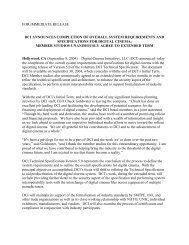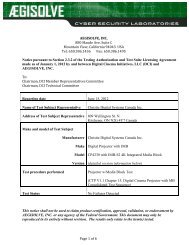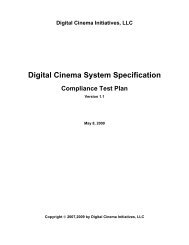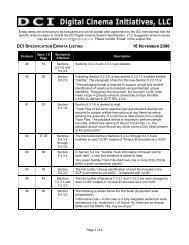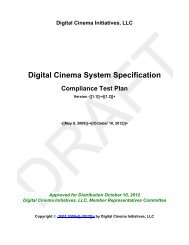DCI Specs - Digital Cinema Initiatives
DCI Specs - Digital Cinema Initiatives
DCI Specs - Digital Cinema Initiatives
You also want an ePaper? Increase the reach of your titles
YUMPU automatically turns print PDFs into web optimized ePapers that Google loves.
7.5.8. Screen Management System (SMS)Each auditorium is required to have a single dedicated Screen Management System (SMS).The Screen Management System provides a user interface to theater management for localcontrol of the auditorium, such as start, stop, select a Show Playlist and edit a Show Playlist.In addition to control, the Screen Management System can monitor and run diagnostics onequipment within the auditorium and provide such status information to the exhibitor. TheScreen Management System is required to operate in one of two modes, local or remote.The following table depicts situations and events related to the Screen ManagementSystem.Item, Observation or IssueCorrupted Movie ReceivedValid Composition Playlist ReceivedMovie prepped for playback is modifiedPlayback time associations of Trailers-Movie<strong>DCI</strong> <strong>Digital</strong> <strong>Cinema</strong> System Specification v.1.2 Page 75ApproachSMS can validate received DCPSMS can validate received CPLSMS can check prepped movie against CPLSMS knows show playlists and execution statisticsTable 10: Examples of Screen Management System EventsThe examples in Table 10 are outside of the knowledge or control of the security system.Under a private agreement between the exhibitor and the distributor, the ScreenManagement System may be required to execute functions or make records of suchactivities under its control.7.5.9. Multiplex Theater System Architecture7.5.9.1. IntroductionMany Theater Systems will be part of a larger multi-screen facility. A single TMS for<strong>Digital</strong> <strong>Cinema</strong> operations is expected to support all multiplex configurations.Figure 13: Multiplex Theater System Architecture below demonstrates an examplearchitecture of one of these systems from an interface prospective. This section willconsider the requirements and interfaces of a large networked system. There are twomain interface components of this larger system. The first is the Media Network and thesecond is the Theater Management Network.7.5.9.2. Media NetworkThe Media Network is a high bandwidth, switched interface, made up of mediainterfaces, Disc Arrays and Media Blocks. The Media Network is required to supportsustained rate of 307 Mbits/sec for compressed image (250 Mbits/sec), audio (37.87Mbits/sec - 16 channels, 24 bit sample, 96 KHz) and subtitle data (subpicture 20MBits/sec) for each screen. Additional data bandwidth is needed for ingesting newcontent and control/monitoring.7.5.9.3. Theater Management Network7.5.9.3.1. IntroductionNot all multi-screen complexes will have Theater Management Networks. Whenpresent, the Theater Management Network is a low bandwidth, shared interface,




